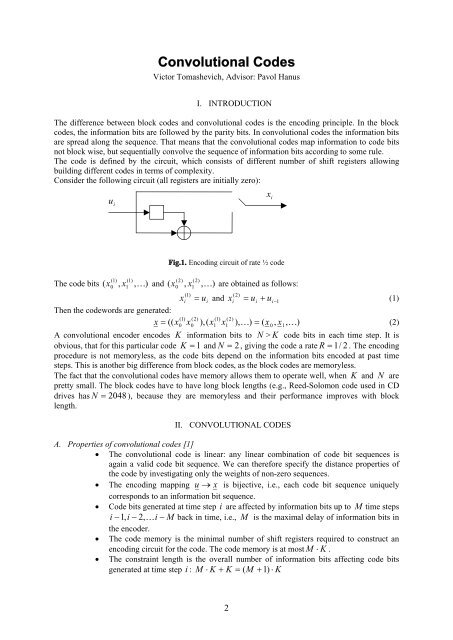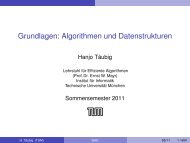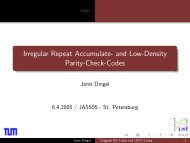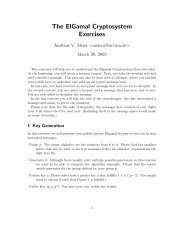Convolutional Codes
Convolutional Codes
Convolutional Codes
You also want an ePaper? Increase the reach of your titles
YUMPU automatically turns print PDFs into web optimized ePapers that Google loves.
<strong>Convolutional</strong> <strong>Codes</strong><br />
Victor Tomashevich, Advisor: Pavol Hanus<br />
I. INTRODUCTION<br />
The difference between block codes and convolutional codes is the encoding principle. In the block<br />
codes, the information bits are followed by the parity bits. In convolutional codes the information bits<br />
are spread along the sequence. That means that the convolutional codes map information to code bits<br />
not block wise, but sequentially convolve the sequence of information bits according to some rule.<br />
The code is defined by the circuit, which consists of different number of shift registers allowing<br />
building different codes in terms of complexity.<br />
Consider the following circuit (all registers are initially zero):<br />
u i<br />
x i<br />
Fig.1. Encoding circuit of rate ½ code<br />
(1) (1)<br />
(2) (2)<br />
The code bits ( x , x , ) and ( x , x , ) are obtained as follows:<br />
0 1<br />
<br />
0 1<br />
<br />
(1)<br />
(2)<br />
xi u i<br />
and x<br />
i<br />
ui<br />
ui<br />
1<br />
(1)<br />
Then the codewords are generated:<br />
(1) (2) (1) (2)<br />
x (( x0 x0<br />
),( x1<br />
x1<br />
), )<br />
( x<br />
0<br />
, x1,<br />
)<br />
(2)<br />
A convolutional encoder encodes K information bits to N > K code bits in each time step. It is<br />
obvious, that for this particular code K 1 and N 2 , giving the code a rate R 1/ 2 . The encoding<br />
procedure is not memoryless, as the code bits depend on the information bits encoded at past time<br />
steps. This is another big difference from block codes, as the block codes are memoryless.<br />
The fact that the convolutional codes have memory allows them to operate well, when K and N are<br />
pretty small. The block codes have to have long block lengths (e.g., Reed-Solomon code used in CD<br />
drives has N 2048 ), because they are memoryless and their performance improves with block<br />
length.<br />
II.<br />
CONVOLUTIONAL CODES<br />
A. Properties of convolutional codes [1]<br />
The convolutional code is linear: any linear combination of code bit sequences is<br />
again a valid code bit sequence. We can therefore specify the distance properties of<br />
the code by investigating only the weights of non-zero sequences.<br />
The encoding mapping u x is bijective, i.e., each code bit sequence uniquely<br />
corresponds to an information bit sequence.<br />
Code bits generated at time step i are affected by information bits up to M time steps<br />
i 1,<br />
i 2, i<br />
M back in time, i.e., M is the maximal delay of information bits in<br />
the encoder.<br />
The code memory is the minimal number of shift registers required to construct an<br />
encoding circuit for the code. The code memory is at most M K .<br />
The constraint length is the overall number of information bits affecting code bits<br />
generated at time step i : M K K ( M 1)<br />
K<br />
2
A convolutional code is systematic if the N code bits generated at time step i<br />
contain the K information bits<br />
Let us consider some examples:<br />
(1)<br />
x i<br />
u i<br />
x<br />
i<br />
(1)<br />
u i<br />
(2)<br />
x i<br />
(3)<br />
x i<br />
(2)<br />
u i<br />
Fig.2. This rate R 1/ 2 code has delay M 1,<br />
memory 1, constraint length 2, and is systematic<br />
Fig.3. This rate R 2 / 3 code has<br />
delay M 1, memory 2, constraint length 4, and<br />
is not systematic<br />
B. Descriptions of convolutional codes<br />
There are multiple ways to describe convolutional codes, the main are [1]:<br />
<br />
<br />
Trellis<br />
Matrix description<br />
First, we consider the description using a trellis. Trellis is a directed graph with at most S nodes,<br />
where S is the vector representing all the possible states of the shift registers at each time stepi . In all<br />
the examples the rate R 1/ 2 code described in Fig.1. is used.<br />
s<br />
0<br />
s1<br />
s<br />
0|00<br />
0|00<br />
2<br />
0 0<br />
0<br />
0|01 1|11<br />
1|11<br />
1<br />
1<br />
1|10<br />
We get the trellis section by considering the<br />
operation of the encoding circuit:<br />
M K<br />
The trellis section has 2 nodes for each<br />
time step.<br />
It is obvious that s i<br />
u i 1<br />
, and the codeword<br />
(1)<br />
(2)<br />
is obtained by x u and x u s .<br />
i<br />
The branches are labeled with u<br />
i<br />
| x<br />
i<br />
. So we<br />
input a new information bit u and it is<br />
written into the shift register, thus s<br />
i<br />
i<br />
i<br />
i<br />
i1 i<br />
,<br />
i<br />
u<br />
and we get a codeword x<br />
i<br />
, generated with<br />
this transition.<br />
The trellis is growing exponentially with M .<br />
As described in [1], we can define a convolutional code, using a generator matrix that describes the<br />
encoding function u x :<br />
x u G<br />
(3)<br />
where<br />
3
G<br />
0<br />
G1<br />
G<br />
2<br />
G<br />
M<br />
<br />
<br />
<br />
G<br />
0<br />
G1<br />
G<br />
2<br />
G<br />
M <br />
G <br />
G G G G <br />
(4)<br />
0 1 2<br />
M<br />
<br />
<br />
<br />
<br />
<br />
The ( K N)<br />
submatricesG m<br />
, m 0,1, ,<br />
M , with elements from GF(2)<br />
specify how an<br />
information bit block u<br />
i m<br />
, delayed m time steps, affects the code bit block x<br />
i<br />
:<br />
x<br />
i<br />
<br />
M<br />
<br />
m0<br />
u<br />
im<br />
G<br />
m<br />
, i<br />
(5)<br />
For this code (in Fig.1.) we need to specify two submatrices, G<br />
0<br />
and as the memory of this code<br />
is M 1, also G<br />
1<br />
. The size of the submatrices must be ( K N)<br />
, and as we have a rate R 1/ 2<br />
code, both submatrices will be of size1 2 .<br />
(1) (2)<br />
The matrix G<br />
0<br />
governs how u<br />
i<br />
affects x<br />
i<br />
( xi<br />
, xi<br />
) : as u<br />
i<br />
affects the first bit of the codeword as<br />
well as the second bit of the codeword the matrix G<br />
0<br />
= 1 1<br />
.<br />
The matrix G1<br />
governs how u<br />
i1<br />
affects x<br />
i<br />
: as u<br />
i1<br />
affects only the second bit of the codeword but<br />
not the first one the matrix G<br />
1<br />
= 0 1<br />
.<br />
For 3 information bit long sequence u u , u , ) using (3) we get<br />
(<br />
0 1<br />
u2<br />
(1) (2) (1) (2) (1) (2)<br />
(( x0 x0<br />
),( x1<br />
x1<br />
),( x2<br />
x2<br />
)) ( u0<br />
, u1,<br />
u2<br />
) G<br />
(6)<br />
As we have 3 information bits at the input and we consider 3 time steps the generator matrix G must<br />
be3 3. The generator matrix is obtained considering the operation of the encoding circuit:<br />
u 0<br />
At time t 0 we input u<br />
0<br />
, as there is<br />
(1) (2)<br />
( x x 0 0<br />
) nothing in the register both code bits are<br />
affected by u<br />
0<br />
. The generator matrix at this<br />
time step is:<br />
11<br />
<br />
<br />
G <br />
<br />
<br />
u 1<br />
u 0<br />
(1)<br />
( x 1<br />
x<br />
(2)<br />
1<br />
)<br />
At time t 1 we input u<br />
1. As u0<br />
is stored at<br />
the register it affects only the second bit of<br />
the code word, u1affects both bits of the<br />
codeword. The generator matrix at this time<br />
step is:<br />
11<br />
01 <br />
<br />
G 11 <br />
<br />
<br />
4
u 2<br />
u 1<br />
(1)<br />
( x 2<br />
x<br />
(2)<br />
2<br />
)<br />
At time t 2 we input u<br />
2<br />
. As u1is stored at<br />
the register it affects only second bit of the<br />
generated codeword, u2<br />
affects both bits of<br />
the codeword and u<br />
0<br />
doesn’t affect anything<br />
as it was already deleted from the register.<br />
Finally we obtain the whole generator<br />
matrix:<br />
11<br />
01 <br />
<br />
G 11 01<br />
<br />
11<br />
C. Puncturing of convolutional codes<br />
The idea of puncturing is to delete some bits in the code bit sequence according to a fixed rule. In<br />
general the puncturing of a rate K / N code is defined using N puncturing vectors. Each table<br />
contains p bits, where p is the puncturing period. If a bit is 1 then the corresponding code bit is not<br />
deleted, if the bit is 0, the corresponding code bit is deleted. The N puncturing vectors are combined<br />
in a N p puncturing matrix P .<br />
Consider code in Fig.1. , without puncturing, the information bit sequence u (0,0,1,1,0 ) generates<br />
the (unpunctured) code bit sequence x<br />
NP<br />
(00,00,11,01,01)<br />
. The sequence x<br />
NP<br />
is punctured using a<br />
puncturing matrix:<br />
1<br />
1 1 0<br />
P 1 <br />
1<br />
0 0 1<br />
(1)<br />
(2)<br />
The puncturing period is 4. Using P 1<br />
, 3 out of 4 code bits x<br />
i<br />
and 2 out of 4 code bits xi<br />
of the<br />
mother codes are used, the others are deleted. The rate of the punctured code is thus<br />
R 1/<br />
2 (4 4) /(3 2) 4 / 5 and u is encoded to x ( 00,0X<br />
,1X<br />
, X1,01)<br />
= (00,0,1,1,01)<br />
The performance of the punctured code is worse than the performance of the mother code. The<br />
advantage of using puncturing is that all punctured codes can be decoded by a decoder that is able to<br />
decode the mother code, so only one decoder is needed. Using different puncturing schemes one can<br />
adapt to the channel, using the channel state information, send more redundancy, if the channel quality<br />
is bad and send less redundancy/more information if the channel quality is better.<br />
D. Decoding of convolutional codes<br />
The very popular decoding algorithm for convolutional codes, used in GSM standard for instance, is<br />
the Viterbi algorithm. It uses the Maximum likelihood decoding principle. The Viterbi algorithm<br />
consists of the following steps for each time index [1]:<br />
1. For all S state nodes at time step j, j 0,1, ,<br />
L / N 1:<br />
Compute the metrics for each path of the trellis ending in the state node. The metric<br />
at the next state node is obtained by adding the path metric to the metric at the<br />
previous corresponding state node. The path metric is obtained by the following<br />
formula, : y x y<br />
(7)<br />
<br />
j<br />
x1 j 1 j 2 j<br />
<br />
2 j<br />
where x is the sent bit, y is the received bit<br />
If the two paths merge, choose the one with the largest metric, the other one is<br />
discarded. If the metrics are equal, the survivor path is chosen by some fixed rule.<br />
5
2. If the algorithm processed d trellis sections or more, choose the path with the largest metric,<br />
go back through the trellis and output the code bit sequence and the information bit sequence.<br />
The parameter d is the decision delay of the algorithm and specifies how many received<br />
symbols have to be processed until the first block of decoded bits is available. As a rule of<br />
thumb, the decision delay is often set to 5 M .<br />
Let us consider a following encoding circuit:<br />
x 1 j<br />
u j<br />
s 1 j<br />
s 2 j<br />
In Fig.4. the corresponding trellis is depicted:<br />
x 2 j<br />
+ 1 + 1<br />
+ 1 / + 1 + 1<br />
+ 1 + 1<br />
- 1 / - 1 - 1<br />
+ 1 - 1<br />
+ 1 / + 1 - 1<br />
+ 1 - 1<br />
- 1 / - 1 + 1<br />
- 1 + 1<br />
- 1 / - 1 + 1<br />
+ 1 / + 1 - 1<br />
- 1 + 1<br />
+ 1 / + 1 + 1<br />
- 1 - 1<br />
- 1 / - 1 - 1<br />
- 1 - 1<br />
s<br />
1 j<br />
, s<br />
2 j<br />
x<br />
1 j<br />
, x<br />
2 j s<br />
1 j 1<br />
, s<br />
2 j 1<br />
Fig. 4. Trellis of convolutional code<br />
The encoded sequence x ( 11,<br />
11,<br />
11,<br />
11,<br />
11,<br />
11,<br />
11)<br />
(BPSK-modulated bits<br />
considered). In the received sequence there are some errors introduced. Fig.5. and Fig.6. show that<br />
hard-decision Viterbi algorithm is performing well in case of single errors.<br />
+1+1<br />
0<br />
+1+1 -1+1 +1+1 +1+1 +1+1 +1+1 +1+1<br />
+2<br />
-2<br />
+2<br />
-2<br />
0<br />
0<br />
-2<br />
+2<br />
+2<br />
+2<br />
-4<br />
+2<br />
-2<br />
0<br />
0<br />
0<br />
0<br />
+4<br />
0<br />
+2<br />
+2<br />
0 -2 +2 0 +2 +4<br />
+6<br />
j=0 j=1 j=2 j=3 j=4 j=5 j=6 j=7<br />
+1+1<br />
0<br />
û<br />
j<br />
<br />
+6<br />
+2<br />
+4<br />
+8<br />
+4<br />
+2<br />
+1 +1 +1 +1 +1 +1 +1 - No error<br />
+10<br />
Fig. 5. Performance of Viterbi algorithm in case of one single error<br />
+1+1 -1+1 +1-1 +1+1 +1+1 +1+1 +1+1<br />
+2<br />
-2<br />
+2<br />
-2<br />
0<br />
0<br />
-2<br />
+2<br />
+2<br />
+2<br />
-4<br />
0<br />
0<br />
+2<br />
+2 +2<br />
-2<br />
+2<br />
+4<br />
-2<br />
+2<br />
-2<br />
0<br />
0<br />
0<br />
0<br />
+2<br />
-2<br />
0<br />
0<br />
0<br />
0<br />
+6<br />
+4<br />
+12<br />
0 +2 +2 +2 +2<br />
0 0 0 -2 +2 -2 +4 -2 +2 -2 +4<br />
j=0 j=1 j=2 j=3 j=4 j=5 j=6 j=7<br />
û<br />
j<br />
<br />
+4<br />
+4<br />
+2<br />
+1 +1 +1 +1 +1 +1 +1 - No error<br />
+6<br />
+2<br />
+4<br />
+2<br />
-2<br />
0<br />
0<br />
0<br />
0<br />
+8<br />
+4<br />
+6<br />
+2<br />
-2<br />
0<br />
0<br />
0<br />
0<br />
+8<br />
+6<br />
+10<br />
+6<br />
+4<br />
6
Fig. 6. Performance of Viterbi algorithm in case of two single errors<br />
Fig.7. shows that the performance of hard-decision Viterbi algorithm degrades significantly in case of<br />
burst errors.<br />
+1+1<br />
0<br />
+1+1 -1-1 -1+1 +1+1 +1+1 +1+1 +1+1<br />
+2<br />
-2<br />
+2<br />
-2<br />
-2<br />
+2<br />
0<br />
0<br />
0<br />
+4<br />
-2<br />
0<br />
0<br />
-2<br />
+2<br />
-2<br />
+2<br />
0<br />
0<br />
+2<br />
+2<br />
-2<br />
0<br />
0<br />
0<br />
0<br />
+2<br />
-2<br />
0<br />
0<br />
0 +2 +2 +2 +2<br />
-2 0 +6 -2 +4 -2 +2 -2 +8 -2 +6<br />
j=0 j=1 j=2 j=3 j=4 j=5 j=6 j=7<br />
û<br />
j<br />
<br />
+2<br />
+2<br />
+8<br />
0<br />
0<br />
+8<br />
+8<br />
+6<br />
+1 -1 -1 +1 +1 +1 +1 - 2 decoding errors<br />
+2<br />
-2<br />
0<br />
0<br />
0<br />
0<br />
+10<br />
Fig. 7. Performance of the Viterbi algorithm in case of error bursts<br />
Fig.8. shows that the application of the soft-decisions Viterbi algorithm improves the situation as the<br />
errors are corrected.<br />
<br />
( m)<br />
j<br />
<br />
x1<br />
jl1<br />
j<br />
y1<br />
j<br />
x2<br />
jl2<br />
j<br />
y2<br />
j<br />
+6<br />
+8<br />
+2<br />
-2<br />
0<br />
0<br />
0<br />
0<br />
+12<br />
+8<br />
+10<br />
l<br />
j<br />
- channel state information<br />
l<br />
j<br />
2<br />
<br />
0.5<br />
“Good” channel<br />
“Bad” channel<br />
+1+1<br />
0<br />
+1+1 -1-1 -1+1 +1+1 +1+1 +1+1 +1+1<br />
G B<br />
+2.5<br />
-2.5<br />
+2.5<br />
-2.5<br />
B B<br />
-1<br />
+1.5<br />
B G<br />
+1.5<br />
+3<br />
G B<br />
+2.5 +5.5<br />
G G<br />
+4<br />
+9.5<br />
G G<br />
+4 +13.5<br />
G G<br />
2 0.5 0.5 0.5 0.5 2 2 0.5 2 2 2 2 2 2<br />
+1<br />
-1.5 -2.5 -4 -4 -4<br />
+3.5 -2.5 0 +1.5 +0.5 +8.5<br />
0 0 +7.5 0 +9.5<br />
+2.5 -1.5 0 0 0<br />
0<br />
-2.5 +1.5 0 +7.5 0+8.5<br />
0<br />
-2.5 +1 +8.5<br />
+12.5<br />
0<br />
+2.5 -1.5 0 0 0<br />
+1.5 +2.5 +4 +4 +4<br />
-2.5 -1.5 +6 -2.5 +3.5 +0.5 +8.5<br />
-4 -4 -4 +7.5<br />
+4<br />
+17.5<br />
j=0 j=1 j=2 j=3 j=4 j=5 j=6 j=7<br />
Fig. 8. Performance of the soft-decision Viterbi algorithm in case of error bursts<br />
III.<br />
CONCLUSION<br />
<strong>Convolutional</strong> codes are very easy to implement. <strong>Convolutional</strong> codes use smaller codewords in<br />
comparison to block codes, achieving the same quality. Puncturing techniques can be easily applied to<br />
convolutional codes. This allows generating a set of punctured codes out of one mother code. The<br />
advantage is that to decode them all only one decoder is needed and adaptive coding scheme can be<br />
thus implemented. One of the most important decoding algorithms is the Viterbi algorithm that uses<br />
the principle of maximum likelihood decoding. The Viterbi decoding uses hard decisions is therefore<br />
very vulnerable to error bursts. Using Soft instead of Hard decisions for Viterbi decoding improves the<br />
performance.<br />
REFERENCES<br />
[1] M. Tuechler and J. Hagenauer. “Channel coding” lecture script, Munich University of<br />
Technology, pp. 111-162, 2003<br />
7



![The ElGamal Cryptosystem[PDF]](https://img.yumpu.com/50668335/1/190x245/the-elgamal-cryptosystempdf.jpg?quality=85)

![Course ''Proofs and Computers``, JASS'06 [5mm] PCP-Theorem by ...](https://img.yumpu.com/33739124/1/190x143/course-proofs-and-computers-jass06-5mm-pcp-theorem-by-.jpg?quality=85)

![Introduction to Complexity Theory [PDF]](https://img.yumpu.com/32815560/1/184x260/introduction-to-complexity-theory-pdf.jpg?quality=85)


![Toda's Theorem II [PDF]](https://img.yumpu.com/10692943/1/190x143/todas-theorem-ii-pdf.jpg?quality=85)